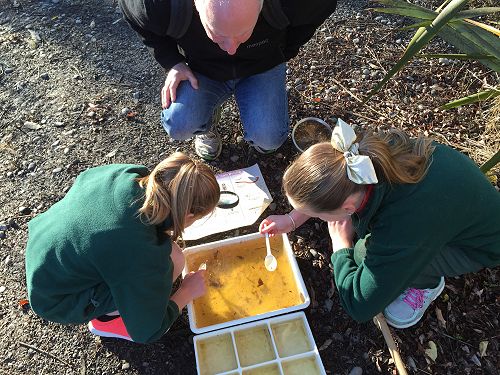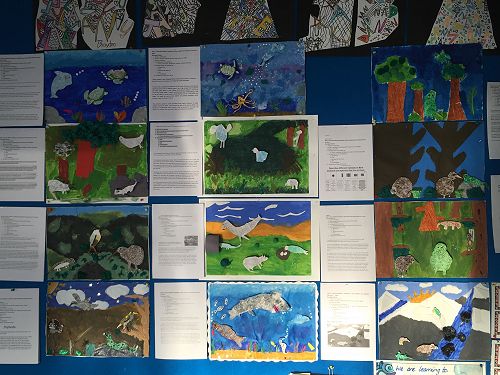
How Can We Protect Habitats and Species?
In Year 5 and 6 this has been the focus question for our Integrated Learning in Term 2. We (Room 11 students) would like to share some of our learning when we visited the Travis Wetlands, some of our collage and paint art of habitats and species plus a description one student wrote.
At the Travis Wetlands we learnt that in 1800 about 90% of Christchurch was covered in Wetlands whereas today it as about 10%. This is the reason the Travis Wetlands are being carefully looked after to protect the creatures, plants and trees that live there naturally.
The Wetlands were compared to:
- a bed and breakfast in that it is where creatures rest and eat.
-a plane in that birds fly in and then out again.
-a sponge in that they soak up water and squeeze it out.
-a sieve in that it filters the water.
- a nest in that it is a home and breeding place for creatures.
We hunted for water creatures in the ponds and were lucky enough to find backswimmers and water boatmen. Some students found larvae for small water creatures too.
We watched the birdlife and found 18 species of birds inhabiting the area like blue, brown and paradise ducks, herons, shags, swallows and swans. The birds had different shaped feet and beaks depending on what they ate and where they mainly lived eg ducks have webbed feet because they swim in the water a lot.
We created food chains for the animals that live in the wetlands and developed a better understanding of what things are producers and consumers. We also learnt that if one part of the food chain is missing the other parts of the food chain are affected too in that their food supply can disappear and they have to adapt to eat something else.
Once back at school we created a piece of art showing a New Zealand habitat and at least 3 creatures that live in it, one endemic, one native and one introduced. You can see some of our art in the pictures below.
We also wrote descriptions of our habitats and descriptions to help people understand what our art was showing and to also share what we had learnt about habitats and species.
Now we are conducting personal inquiries into how we can make changes to protect New Zealand's habitats and species.
Habitat and species descriptive writing by Franz
I have created a New Zealand ocean habitat and included 3 creatures that live there, one endemic, one native and one introduced.
The Ocean habitat is 70% of Earth and the deeper you go in the ocean the darker it gets. The ocean contains seaweed, algae, kelp, sponges and coral reefs. The ocean water freezes at -1.94 degrees Celsius. That means it is so cold that ice can form. The average temperature of the Ocean surface waters is about 17 degrees Celsius. Animals that live in the Ocean needs to have gills because gills are for breathing water. The Ocean is responsible for weather because Pacific Ocean water gets evaporated and floats up to the sky to the Stratosphere and that is the place where the evaporated water cools down and turns to clouds, but if a lot of evaporated water goes in a cloud it turns to a rain cloud but a lot of evaporated water = storm/cyclone.
The endemic creature I have chosen is the Longfin Eel. The Longfin Eel is the longest and only and endemic eel in NZ. The eel is 73.5 cm in length. The Longfin Eel is Endemic to New Zealand, the Longfin Eel, so-named because its dorsal (top) fin is longer than its bottom fin, is probably the biggest Eel in the world. It is slow growing and sometimes lives for 80 years, some females can reach 2 metres long and weigh up to 40kg.
The native creature I have is Hector's Dolphin. The Hector's Dolphin is one of the smallest marine Dolphin in the world. They grow up to 1.5metres in length and ONLY found in New Zealand. Two subspecies of Hector’s Dolphins exist: the South Island Hector’s Dolphin which is found around the South Island of New Zealand, and the Māui Dolphin which is found off the West Coast of the North Island.
The introduced creature I have is the Great White Shark. The female Shark gets up to 6.4 and 4.5 meters. Sharks rarely attack humans. Great White Sharks have an amazing sense of smell. It is believed they can smell single drops of blood in the water. They also have good eyesight and hearing so they have no trouble hunting for food any time of day or night.
In conclusion The Longfin Eel, Hector’s Dolphin and The Great White Shark live in the New Zealand ocean habitat.
You will find photos of our learning below.
Gallery












